
Valle de Angeles & Santa Lucia,
Honduras
September 1999
Valle de Angeles and Santa Lucia are a day trip from Tegucigalpa. We hired a bilingual tour guide, Rodolfo H. Paz Alemán, who works for Marcris Travel Agency. (when he isn't attending civil engineering classes at the National University). The agency is located at Col. Ruben Dario, Avenida José Maria Medina #320. In addtion to tours and airport/hotel transfers, Marcris also offers car rental service with use of an optional cell phone and a fullservice travel agency The trip out to Santa Lucia/Valle de Angeles was made in an air conditioned Nissan quad cab pickup truck. The road to Valle de Angeles and Santa Lucia had major damage as a result of Hurricane Mitch in 1998. The road is passable but there is still major construction and repair work going on. In addition, torrential downpours a few days before we drove up resulted in some of the new construction being washed out before completion. Iintersting sights along the road include nurseries that provide landscape plants, handicraft venors, produce vendors, and even an Escuela de Perro, a school for the training of protection dogs (which seem to be very popular in the upscale area of Tegucigalpa).
Santa Lucia is about 13 km from the capital on a spur road off the road from Tegucigalpa to Valle de Angeles. Once an important mining center early in the colonial period, Santa Lucia is now a small, quiet community nestled on a hillside with wonderful vistas of Tegucigalpa. There are "two" town centers: the traditional town center with the church and municipal building and another area with a lake and park. The steep, narrow streets are cobblestone and the buildings are whitewashed stucco with tile roofs. Ignore the trappings of modern civilization (automobiles, Pepsi Cola signs, etc.) and it is easy to imagine being in another century. The church is a simple structure (although slightly more ornate than the church in Siguatepeque) but it does contain religious artwork. The statue of the black Christ is reported to have been a gift from King Phillip of Spain and was sculpted more than 400 years ago. There are a few small handicrafts shops but they were closed for the Independence Day holiday on the day we visited. We did not get to see the Black Christ statue as the church was locked on this day also. |

| We drove back out to the main road to Valle de Angeles and continued our trip. Along the way, the requisite cattle, burros, and horses were seen grazing along the roadsides. As you approach Valle de Angeles the entrance to the Florida Club is on the left. This is a family oriented vacation resort that includes a hotel, tennis, play areas for the children, and horseback riding. The equine stock is Peruvian Paso Fino. This year the owner auctioned off surplus Paso Fino horses while we were visiting the area. Paso Fino horses are not strictly confined to the resort though. We did notice Paso Finos being ridden in town. We were not quite sure it actually was a Paso Fino until the woman rider rode off, and then the highly unique gait was visible and audible on the cobblestone streets. Visible in the picture is one of the ever present street vendors selling hammocks. Another smaller horse, the native breed, was also seen. This horse is a general purpose horse that can be ridden or used as a pack animal. All of the smaller native horses we saw were very people and traffic oriented. The temperment was calm and quiet, even the stallions. Below are two photos of this smaller horse whose gait resembles that of a Tennessee Walker. |
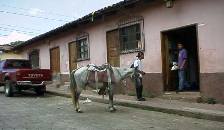 |
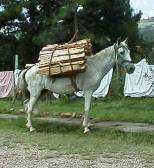 |
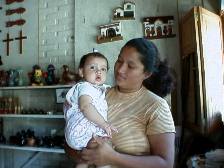 Mother and child at work in a handicraft shop |
 A local handicraft "shop dog" |
Valle de Angeles is a slightly larger town, but it still retains a quiet, rural charm. Weekends can be busy as this town is a get away destination for wealthy Hondurans and foreign tourists alike. We were there on a weekend and did not find it overly crowded. It is a major handicrafts center and a school that teaches native crafts is locatred there. Good buys are available on mahogany products as well as leather and pottery. As in most Central American towns, the center of town is a plaza/park with the church and municipal buildings located here. The town still has the atmosphere of a Spanish colonial era town and is very relaxed and "laid back " kind of place. |
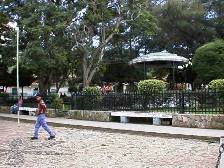 |
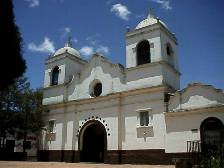 |
